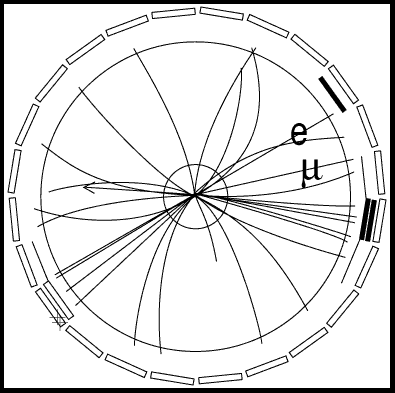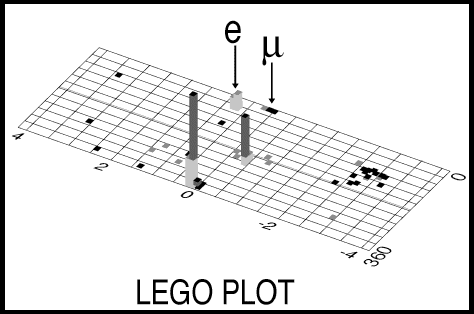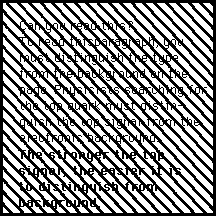Inquiring Minds
|
Physics at Fermilab main page | accelerators | collider experiments | neutrino physics | technology computing | theory | astrophysics | discoveries at Fermilab |
|||
|
|||
A proton, moving as fast as a proton can be made to move on earth, smashes head-on into an antiproton moving just as fast the other way. Proton and antiproton smash to bits, pieces flying in all directions. The pieces are subatomic particles--perhaps a dozen different kinds produced in any one collision. One of them might be the top quark. How do we know? Is it time to call the reporters with news of a discovery? Or is it just another day at the high-energy physics frontier? A collision is over so fast we could never see it happen. However, before they vanish, most of the particles produced in a collision leave behind their electronic "signatures" in a particle detector's guest book, as it were. To learn what took place in a collision, physicists use computers to examine these electronic signatures. From them, the physicists determine which of several hundred possible particles were present at the scene. Most of the guest list reveals the same old crowd, particles that turn up so often that the computers are taught to ignore them. Much less often, say one time in a million, an interesting signature turns up, and the computer takes note. It might be the mark of one of several intriguing particles. One time in a few billion, they find the handwriting of top.
A computer simulation of a proton-antiproton collision. The tracks show the paths of different kinds of particles created in the collision.
Physicists recognize particles produced in collisions by their electronic signatures, shown graphically by computers. A "lego plot" shows one characteristic signature pattern we expect to see in the decay of a top quark. The height of each lego tower shows the amount of energy detected in each section of a detector's calorimeter. Although we can't see the top quark itself, we can recognize its signature. Some particles, including top, exist for such a short time before they decay into other particles that we don't actually find their signatures. Instead, we see the signatures of their decay products. A particle we are looking for may have more than one possible way of decaying--top has many decay channels--and thus more than one possible signature.
Physicists keep asking themselves, "Have I thought of all possible backgrounds?"
Fermilab's Tevatron has enough energy--just enough--for the top quark to appear very rarely, once in a few billion collisions. Identifying the top quark requires distinguishing a real top signature from those of other processes, called background, that can mimic a top signature. To discover top, physicists must show conclusively that its signature appears statistically more often than they would expect to see it from the background alone. In other words, if we expect to see four top-like signatures from background in a certain number of collisions, we must see more than that many to be sure we're seeing top. But how many more? Here comes the statistical part. When we say that we expect to see four background events, it doesn't mean that every single experiment would see exactly four. Sometimes we might see two, sometimes six. If we repeated the experiment many times the average would be four, but any particular experiment might see a fluctuation to a larger or a smaller number. To be sure that we're seeing top, we require so many events above the expected background that the probability of mistaking it for a background fluctuation is so small we can ignore it. We also need to understand the backgrounds themselves. Physicists keep asking themselves, "Have I thought of all possible backgrounds?" The discovery of the top quark was not a "Eureka" event--not the sudden sighting of the long-sought particle. "We discovered the top quark not in one lightning stroke, but over a long period of time, event by event," says physicist Nick Hadley, a DZero collaborator. "No single piece of evidence, no matter how strong, was enough to let us claim a discovery. We couldn't be sure we had found the top quark until we had seen so many events with the right characteristics that there was almost no chance the statistics were fooling us into making a false claim." Evidence can be interpreted in different ways, but a discovery requires such good evidence that it really cannot be interpreted in any other way. Before they could claim a discovery, Fermilab experimenters who found evidence of the top quark had to be sure that they were seeing real signals from top quarks, not merely background events. Only when the weight of evidence became so great that the chance of mistaking background for signal was vanishingly small could experimenters announce the discovery of the top quark. |
| last modified 02/26/2001 email Fermilab |
FRLsDFx9eyfrPXgV






